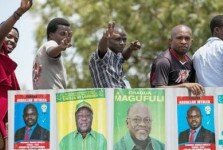The SA Army Combat Training Centre (CTC) is in the final preparation stage to hosting a multi-country force field training exercise that will see more than five thousand soldiers, police and civilians descend on Lohathla in the Northern Cape.
SANDF Joint Operations Chief, Lieutenant General Derrick Mgwebi, said there are five regional economic communities, all African Union (AU) structures, contributing to Amani Africa II which has as its final aim the operationalisation of the African Standby Force (ASF).
They are the North African Regional Capability (NARC), East African Community (EAC), Economic Community of Central African States (ECCAS), Southern African Development Community (SADC) and the Economic Community of West Africa States (ECOWAS).
Officially Amani Africa will evaluate the state of readiness of the ASF and exercise it rapid deployment capability (RDC).
The exercise starts on October 26 with a rapid deployment as a start-up operation followed by a full multi-dimensional peace support operation before finish and demobilisation on November 4.
A breakdown of important aspects of Amani Africa II are strategic lift and movement of personnel, vehicles and equipment to CTC (October 12 to 16); final exercise preparation (October 17 and 18); opening ceremony (October 19); induction training, orientation programmes and deployment drills (October 20 to 25); rapid deployment capability (October 26 to 29); mission transition to peace support (October 30 and 31); peace support operation (November 1 to 4); VIP day (November 5); demobilisation (November 6 to 9) and movement of personnel, vehicles and equipment out of South Africa (November 7 to 15).
Major troop contributing countries are Angola, Botswana, Democratic Republic of Congo, Lesotho, Malawi, Mozambique, Namibia, South Africa, Swaziland, Zambia and Zimbabwe. Other countries involved in either contributing or participating are Algeria, Burundi, Egypt, Ethiopia, Gambia, Ghana, Kenya, Nigeria, Rwanda and Uganda.
The exercise is based on a scenario created in a fictitious country named the Republic of Carana. The exercise setting provides for two scenarios to address the aim of the exercise.
The first scenario (Scenario 6) is based on a report that the security situation in Carana has deteriorated to an extent the AU has deemed it necessary to deploy its RDC to address the situation. This will then give the AU, acting on AU Scenario 6 and Chapter 7 of the United Nations Charter an authority to intervene by deploying the RDC of its standby force. This then provides the AU with an opportunity to exercise its RDC.
The second scenario (Scenario 5) is based on a report that the security situation has changed and the situation is conducive for the deployment of a traditional and multi-dimensional peacekeeping force for Peace Support Operations. This will give an AU, acting on AU Scenario 5 and Chapter 6 of the United Nations Charter an opportunity to evaluate the state of readiness of the ASF to undertake a peacekeeping mission.




